өц…бБ¶өц”бһ¶өц”бҹӢөцИИБ¶өцҸбһёөц–бһёөцё§һёөцҸбһ·өцңбһ·өц’бһёөц”бһҺбҹ’бһҸөц№бһ„өц‘бһ¶өц¶ДбҹӢбАҪөц„бҹӢөцё§һ·өц„бһӢөц¶бһ“бҹҲбһ”өц»бһӮбҹ’бһӮөцӣ
0 likes612 views
1 of 13
Download to read offline
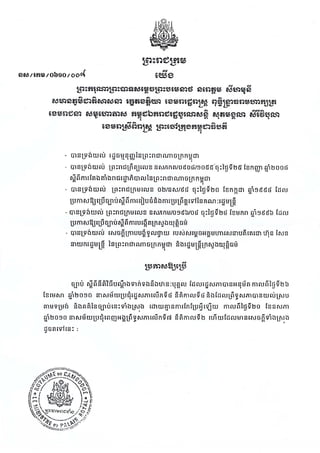
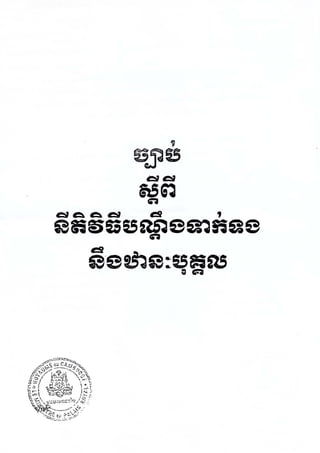
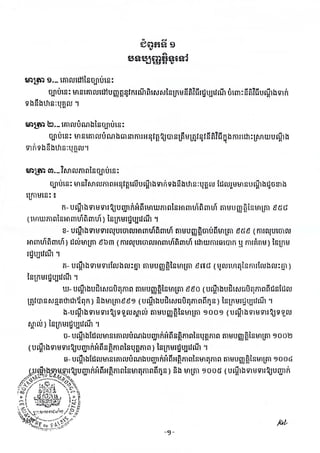
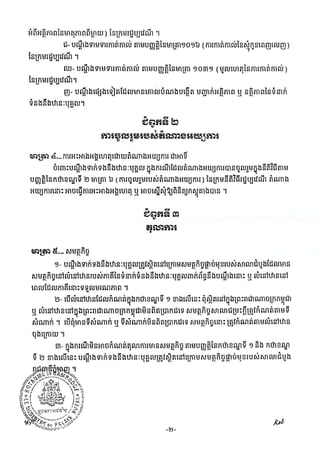
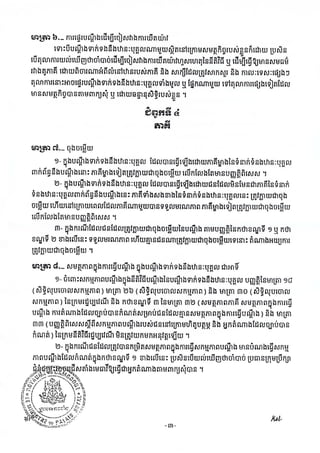


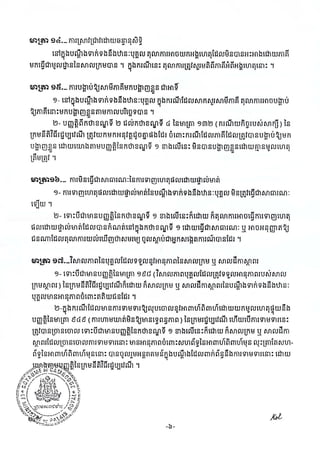
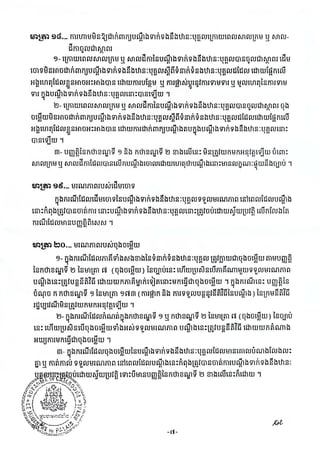

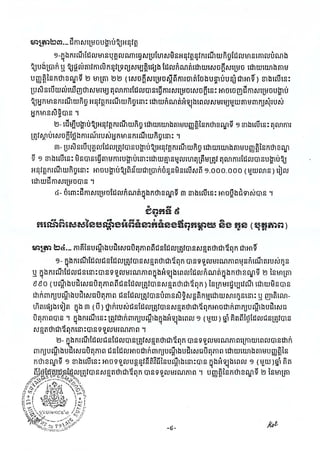


Ad
Recommended
Hersey blanchard leadership theory
Hersey blanchard leadership theoryWai Sin Yoong
Мэ
The document discusses the Hersey-Blanchard Situational Leadership Model, which explains how to match leadership style to a situation based on followers' readiness and ability. It identifies four leadership styles - telling, selling, participating, and delegating - which vary in the amount of task behavior and relationship behavior from the leader. The model also defines readiness, ability, and willingness as factors that determine a follower's situational readiness to perform a task.Ш§Щ„Щ…ШӯШ§Ш¶ШұШ© Ш§Щ„Ш«Ш§Щ„Ш«Ш© ШӘШ®Ш·ЩҠШ· Ш§Щ„Щ…Ш®ШІЩҲЩҶ.pptx
Ш§Щ„Щ…ШӯШ§Ш¶ШұШ© Ш§Щ„Ш«Ш§Щ„Ш«Ш© ШӘШ®Ш·ЩҠШ· Ш§Щ„Щ…Ш®ШІЩҲЩҶ.pptxDr. Mohammed Emmam
Мэ
Ш§Щ„ЩҲШ«ЩҠЩӮШ© ШӘШӘШ№Щ„ЩӮ ШЁШҘШҜШ§ШұШ© Ш§Щ„Щ…Ш®Ш§ШІЩҶ ЩҲШӘШ·ЩҲЩҠШұ Ш§Щ„Щ…ЩҮШ§ШұШ§ШӘ Ш§Щ„Щ…ШӘШ№Щ„ЩӮШ© ШЁШ°Щ„Щғ. ШӘШӘЩҶШ§ЩҲЩ„ Ш§Щ„Щ…ЩҲШ¶ЩҲШ№Ш§ШӘ Ш§Щ„ШұШҰЩҠШіЩҠШ© Щ…Ш«Щ„ Ш§Щ„ШӘШ®Ш·ЩҠШ· ЩҲШ§Щ„ШӘЩҶШёЩҠЩ… ЩҲШ§Щ„ШӘЩҲШёЩҠЩҒ ЩҲШ§Щ„ШӘЩҲШ¬ЩҠЩҮ ЩҲШ§Щ„ШұЩӮШ§ШЁШ©. ЩҠШіШӘЩҮШҜЩҒ Ш§Щ„ШЁШұЩҶШ§Щ…Ш¬ Ш§Щ„ЩҒШҰШ§ШӘ Ш§Щ„Щ…Ш№ЩҶЩҠШ© ШЁШҘШҜШ§ШұШ© Ш§Щ„Щ…Ш®Ш§ШІЩҶ ЩҲШӘЩӮШҜЩҠЩ… ШӘЩӮЩҶЩҠШ§ШӘ ШӯШҜЩҠШ«Ш© ЩҒЩҠ ЩҮШ°Ш§ Ш§Щ„Щ…Ш¬Ш§Щ„.Motivation
MotivationShahi Raz Akhtar
Мэ
The document discusses various theories of motivation including: Maslow's hierarchy of needs, ERG theory, McClelland's needs theory, equity theory, expectancy theory, goal-setting theory, reinforcement theory, and Herzberg's two-factor theory. It also discusses the importance of motivation for employee performance and retention. An integrated model is presented showing how individual motivation is influenced by attributes, performance, satisfaction, and extrinsic/intrinsic rewards within an organizational context. Strategies for motivating employees through job design and behavior modification are also outlined.Management Chapter-7
Management Chapter-7pasha99mkt
Мэ
This document discusses the key elements of planning and decision making for organizations. It covers topics such as:
- The importance of decision making and how it drives the planning process.
- The different types of goals organizations set, including mission statements, strategic goals, and operational goals. Goals provide guidance, promote planning, and serve as a motivation and evaluation tool.
- The various levels and timeframes of planning including strategic plans, tactical plans, operational plans, long-range plans, and short-range plans.
- Responsibilities for planning including planning staff, boards of directors, CEOs, line management, and contingency/crisis planning.
- Barriers to effective goal setting and planningЩ…ШЁШ§ШҜЩҠЩ” ЩҲШ®Ш·ЩҲШ§ШӘ Ш§Щ•ШҜШ§ШұШ© Ш§Щ„Щ…ШҙШ§ШұЩҠШ№
Щ…ШЁШ§ШҜЩҠЩ” ЩҲШ®Ш·ЩҲШ§ШӘ Ш§Щ•ШҜШ§ШұШ© Ш§Щ„Щ…ШҙШ§ШұЩҠШ№Youth Forum Organization
Мэ
ЩҠШӘЩҶШ§ЩҲЩ„ Ш§Щ„ЩҲШ«ЩҠЩӮШ© ШҘШҜШ§ШұШ© Ш§Щ„Щ…ШҙШ§ШұЩҠШ№ Щ…ЩҶ Ш®Щ„Ш§Щ„ Ш®Щ…Ші Ш®Ш·ЩҲШ§ШӘ ШұШҰЩҠШіЩҠШ©: Ш§Щ„ШӘЩ…ЩҮЩҠШҜШҢ Ш§Щ„ШӘШ®Ш·ЩҠШ·ШҢ Ш§Щ„ШӘЩҶЩҒЩҠШ°ШҢ Ш§Щ„Щ…ШӘШ§ШЁШ№Ш© ЩҲШ§Щ„ШӘШӯЩғЩ…ШҢ ЩҲШ§Щ„ШҘЩҶЩҮШ§ШЎ. ШӘШҙЩ…Щ„ Ш§Щ„Ш®Ш·ЩҲШ§ШӘ ШӘШӯЩ„ЩҠЩ„ Ш§Щ„Щ…ШӘШ·Щ„ШЁШ§ШӘШҢ ЩҲШ¶Ш№ Щ…ЩҠШІШ§ЩҶЩҠШ©ШҢ ШҘШҜШ§ШұШ© Ш§Щ„Щ…Ш®Ш§Ш·ШұШҢ ЩҲШ¶Щ…Ш§ЩҶ ШӘШіЩ„ЩҠЩ… Ш§Щ„Щ…ШҙШұЩҲШ№ ЩҲЩҒЩӮШ§ЩӢ Щ„Щ„Ш¬ШҜШ§ЩҲЩ„ Ш§Щ„ШІЩ…ЩҶЩҠШ© ЩҲШ§Щ„Щ…ЩҠШІШ§ЩҶЩҠШ© Ш§Щ„Щ…ШӯШҜШҜШ©. ЩғЩ…Ш§ ШӘШӨЩғШҜ Ш§Щ„ЩҲШ«ЩҠЩӮШ© Ш№Щ„Щү ШЈЩҮЩ…ЩҠШ© Ш№Щ…Щ„ЩҠШ© Ш§Щ„Щ…ШӘШ§ШЁШ№Ш© Щ„Ш¬Щ…Ш№ Ш§Щ„Щ…Ш№Щ„ЩҲЩ…Ш§ШӘ ЩҲШӘШӯЩ„ЩҠЩ„ЩҮШ§ Щ„Ш¶Щ…Ш§ЩҶ ШӘЩҲШ§ЩҒЩӮ ШіЩҠШұ Ш§Щ„Ш№Щ…Щ„ Щ…Ш№ Ш§Щ„Ш®Ш·Ш© Ш§Щ„Щ…ШӘЩҒЩӮ Ш№Щ„ЩҠЩҮШ§.Ш§ЩғШӘШҙЩҒ Ш§Щ„Щ…ШҜЩҠШұ Ш§Щ„ЩҶШ§Ш¬Шӯ ЩҒЩҠ ШҜШ§Ш®Щ„Щғ
Ш§ЩғШӘШҙЩҒ Ш§Щ„Щ…ШҜЩҠШұ Ш§Щ„ЩҶШ§Ш¬Шӯ ЩҒЩҠ ШҜШ§Ш®Щ„ЩғA. M. Wadi Qualitytcourse
Мэ
ЩҠШӘЩҶШ§ЩҲЩ„ Ш§Щ„ЩҲШ«ЩҠЩӮШ© Щ…ЩҒЩҮЩҲЩ… Ш§Щ„ШҘШҜШ§ШұШ© Ш§Щ„ЩҶШ§Ш¬ШӯШ© ЩҲШЈЩҮЩ…ЩҠШ© ШҜЩҲШұ Ш§Щ„Щ…ШҜЩҠШұ ЩҒЩҠ ШӘШӯЩӮЩҠЩӮ Ш§Щ„ШЈЩҮШҜШ§ЩҒ Ш§Щ„Щ…ШӨШіШіЩҠШ©ШҢ Щ…Ш№ Ш§Щ„ШӘШұЩғЩҠШІ Ш№Щ„Щү ЩҲШёШ§ШҰЩҒ Ш§Щ„ШҘШҜШ§ШұШ© Щ…Ш«Щ„ Ш§Щ„ШӘШ®Ш·ЩҠШ· ЩҲШ§Щ„ШӘЩҶШёЩҠЩ… ЩҲШ§Щ„ЩӮЩҠШ§ШҜШ©. ЩғЩ…Ш§ ЩҠШӘШ·ШұЩӮ ШҘЩ„Щү Ш§Щ„Щ…ШЁШ§ШҜШҰ Ш§Щ„ШЈШіШ§ШіЩҠШ© Ш§Щ„ШӘЩҠ ЩҠШ¬ШЁ ШЈЩҶ ЩҠШӘШЁШ№ЩҮШ§ Ш§Щ„Щ…ШҜЩҠШұ Щ„Ш¶Щ…Ш§ЩҶ ЩҒШ№Ш§Щ„ЩҠШ© Ш§Щ„ШЈШҜШ§ШЎ ЩҲШ§Щ„Ш§ШЁШӘЩғШ§Шұ ЩҒЩҠ Ш§Щ„ЩҒШұЩҠЩӮ. ШЁШ§Щ„ШҘШ¶Ш§ЩҒШ© ШҘЩ„Щү Ш°Щ„ЩғШҢ ШӘШЁШұШІ ШЈЩҮЩ…ЩҠШ© Ш§Щ„Щ…ЩҮШ§ШұШ§ШӘ Ш§Щ„ШҘШҜШ§ШұЩҠШ© Ш§Щ„Щ…Ш®ШӘЩ„ЩҒШ©ШҢ Щ…Ш«Щ„ Ш§Щ„Щ…ЩҮШ§ШұШ§ШӘ Ш§Щ„ЩҒЩҶЩҠШ© ЩҲШ§Щ„ШӘЩҲШ§ШөЩ„ЩҠШ© ЩҲШ§Щ„ШҘЩҶШіШ§ЩҶЩҠШ©ШҢ ЩҒЩҠ ЩҶШ¬Ш§Шӯ ШЈЩҠ Щ…ШҙШұЩҲШ№ ШЈЩҲ Щ…ШӨШіШіШ©.Leadership theories[1]
Leadership theories[1]Katherine Barnachea
Мэ
The document provides an overview of several leadership theories including:
1. Great Man Theory which assumes that great leaders are born, not made.
2. Trait Theory which focuses on inherent traits and skills that make an effective leader.
3. Behavioral Theory which looks at observable behaviors of successful leaders and assumes leadership can be learned.
4. Contingency Theories examine how leadership style depends on situational factors like follower readiness and ability.
The summary highlights some of the key assumptions, descriptions, and discussions around these influential leadership theories.02 Ш§Щ„Ш№Ш§ШҜШ§ШӘ Ш§Щ„ШіШЁШ№ Щ„ШЈЩғШ«Шұ Ш§Щ„ЩҶШ§Ші ЩҒШ§Ш№Щ„ЩҠШ©
02 Ш§Щ„Ш№Ш§ШҜШ§ШӘ Ш§Щ„ШіШЁШ№ Щ„ШЈЩғШ«Шұ Ш§Щ„ЩҶШ§Ші ЩҒШ§Ш№Щ„ЩҠШ©Abdallah Yakoub
Мэ
ЩҠШӘШӯШҜШ« Ш§Щ„Щ…ШіШӘЩҶШҜ Ш№ЩҶ ШЈЩҮЩ…ЩҠШ© ШӘШ·ЩҲЩҠШұ Ш§Щ„Ш°Ш§ШӘ Щ…ЩҶ Ш®Щ„Ш§Щ„ Ш§Щ„Ш№Ш§ШҜШ§ШӘ Ш§Щ„ШіШЁШ№ Щ„Щ„ШЈШҙШ®Ш§Шө Ш§Щ„ШЈЩғШ«Шұ ЩҒШ№Ш§Щ„ЩҠШ©ШҢ ЩҲШ§Щ„ШӘЩҠ ШӘШҙЩ…Щ„ Ш§Щ„Щ…ШЁШ§ШҜШұШ© ЩҲШ§Щ„ШӘШ®Ш·ЩҠШ· Ш§Щ„Ш¬ЩҠШҜ ЩҲШҘШҜШ§ШұШ© Ш§Щ„ШЈЩҲЩ„ЩҲЩҠШ§ШӘ ЩҲШ§Щ„Ш№Щ…Щ„ Ш§Щ„Ш¬Щ…Ш§Ш№ЩҠ. ЩғЩ…Ш§ ЩҠШіШӘШ№ШұШ¶ Щ…ШЁШ§ШҜШҰ ШЈШіШ§ШіЩҠШ© Щ„ШӘШӯЩӮЩҠЩӮ Ш§Щ„ЩҶШ¬Ш§Шӯ Ш§Щ„ШҙШ®ШөЩҠ ЩҲШ§Щ„Щ…ЩҮЩҶЩҠШҢ Щ…Ш«Щ„ ШӘШӯЩ…Щ„ Ш§Щ„Щ…ШіШӨЩҲЩ„ЩҠШ© ЩҲЩҒЩҮЩ… Ш§Щ„ШўШ®ШұЩҠЩҶ ЩҲШ§Щ„ШӘШ№Ш§ЩҲЩҶ. ЩҠЩҸШЁШұШІ Ш§Щ„Щ…ШіШӘЩҶШҜ ШҜЩҲШұ Ш§Щ„ШӘЩҒЩғЩҠШұ Ш§Щ„ШҘЩҠШ¬Ш§ШЁЩҠ ЩҲШ¶ШұЩҲШұШ© Ш§Щ„ШӘШ®Ш·ЩҠШ· Щ„ШӘШӯЩӮЩҠЩӮ Ш§Щ„ШЈЩҮШҜШ§ЩҒ Ш§Щ„ШӯЩҠШ§ШӘЩҠШ©.Chapter 4: Planning in Islam
Chapter 4: Planning in IslamMohd Adib Abd Muin, Senior Lecturer at Universiti Utara Malaysia
Мэ
1. The document discusses planning in Islam, defining it as determining objectives and deciding future courses of action to achieve goals.
2. It provides evidence of planning in the Quran and examples from prophets like Moses, who planned carefully in his mission to free the Israelites from Egypt.
3. Prophet Muhammad praised people with vision and foresight, like Sa'id ibn Mu'ath for his strategic plan in the Battle of Badr, which centered on protecting the Prophet.Contingency theory
Contingency theoryMaryAlyssaBotin
Мэ
The document discusses contingency theory, which states that there is no single best way to lead and that leadership style depends on various internal and external factors. It describes Fred Fiedler's contingency model of leadership, which proposes that a leader's effectiveness depends on matching their leadership style (either task-focused or relationship-focused) to the favorability of the situation based on factors like the leader-member relationship, task structure, and the leader's power. The document also outlines other theorists who contributed to situational leadership theory and describes the different leadership styles and maturity levels in Hersey and Blanchard's model.Organizational behaviour lession 1 development of ob
Organizational behaviour lession 1 development of obrbk1040
Мэ
The document covers the development and significance of organizational behavior (OB) as a foundational course in business studies, emphasizing key theories and concepts related to human behavior in organizations. It highlights historical foundations such as scientific management by Frederick W. Taylor, the theory of administration by Henri Fayol, and the human relations movement, along with contemporary issues such as workforce diversity and motivation. The document aims to equip students with competencies necessary for effective participation in organizational settings.Contingency theories of leadership
Contingency theories of leadershipAnurag Chaturvedi
Мэ
Fiedler's contingency model, cognitive resource theory, situational leadership theory, and path-goal theory are contingency theories of leadership that consider the situation. Fiedler's model asserts that a leader's style is fixed but the situation can be changed to fit the leader. Situational leadership theory and path-goal theory propose that a leader's style should be adapted to fit the situation, including follower readiness and environmental factors. Cognitive resource theory examines how a leader's intelligence and experience interact with stress levels in a situation to determine effectiveness.Management Vs Leadership
Management Vs LeadershipMarvin Nurse
Мэ
The document emphasizes the distinction between management and leadership, highlighting that effective leadership is about vision, communication, and motivating others. It outlines tools and assessments for self-awareness in leadership style and the importance of decision-making processes. The content encourages transforming management practices to inspire and lead organizations beyond the status quo.Ш§Щ„ШӘШ®Ш·ЩҠШ· Ш§Щ„Ш§ШіШӘШұШ§ШӘЩҠШ¬ЩҠ ЩҲ ШӘШӯШҜЩҠШҜ Ш§Щ„Ш§ЩҮШҜШ§ЩҒ
Ш§Щ„ШӘШ®Ш·ЩҠШ· Ш§Щ„Ш§ШіШӘШұШ§ШӘЩҠШ¬ЩҠ ЩҲ ШӘШӯШҜЩҠШҜ Ш§Щ„Ш§ЩҮШҜШ§ЩҒMohamed Ahmed Fouad
Мэ
Ш§Щ„ЩҲШ«ЩҠЩӮШ© ШӘЩҶШ§ЩӮШҙ ШЈЩҮЩ…ЩҠШ© Ш§Щ„ШӘШ®Ш·ЩҠШ· ЩҒЩҠ ШӘШӯШҜЩҠШҜ Ш§Щ„ШЈЩҮШҜШ§ЩҒ ЩҲШӘШЈШ«ЩҠШұЩҮ Ш§Щ„ШҘЩҠШ¬Ш§ШЁЩҠ Ш№Щ„Щү Ш§Щ„ЩҶШ¬Ш§Шӯ Ш§Щ„Щ…ЩҮЩҶЩҠ ЩҲШ§Щ„ШҙШ®ШөЩҠ. ШӘШӘЩҶШ§ЩҲЩ„ Щ…Ш®ШӘЩ„ЩҒ ШЈЩҶЩҲШ§Ш№ Ш§Щ„Ш®Ш·Ш· ЩҲШ§Щ„Ш®Ш·ЩҲШ§ШӘ Ш§Щ„Щ„Ш§ШІЩ…Ш© Щ„ЩҲШ¶Ш№ЩҮШ§ ШЁШ§Щ„ШҘШ¶Ш§ЩҒШ© ШҘЩ„Щү Ш§Щ„ШЈШ®Ш·Ш§ШЎ Ш§Щ„ШҙШ§ШҰШ№Ш© Ш§Щ„ШӘЩҠ ЩҠШ¬ШЁ ШӘШ¬ЩҶШЁЩҮШ§. Ш§Щ„ШӘШЈЩғЩҠШҜ Ш№Щ„Щү ШЈЩҶ Ш§Щ„ШӘШ®Ш·ЩҠШ· Ш§Щ„Ш¬ЩҠШҜ ЩҠШ№ШІШІ Щ…ЩҶ Ш§Щ„ШӘЩҶШіЩҠЩӮ ШЁЩҠЩҶ Ш§Щ„ШЈЩҮШҜШ§ЩҒ Ш§Щ„ЩҒШұШҜЩҠШ© ЩҲШЈЩҮШҜШ§ЩҒ Ш§Щ„Щ…ШӨШіШіШ© Щ„ШӘШӯЩӮЩҠЩӮ Ш§Щ„ЩҶШ¬Ш§Шӯ.Organizational behavior
Organizational behaviorMoatasem Mabrouk
Мэ
Organizational behavior is a field that studies how individuals, groups, and structure influence behavior within organizations. It draws from various behavioral science disciplines like psychology, sociology, and anthropology. OB aims to apply knowledge to improve organizational effectiveness. Some key points covered in the document include:
- OB examines influences on behavior at the individual, group, and organizational level as well as from the external environment.
- Major managerial roles and functions are planning, organizing, leading, and controlling. Effective managers allocate more time to human resource management and communication.
- Several perspectives can be used to view organizations, such as machines, organisms, cultures, and political systems.
- Studying OB provides insights into managing people andLeadership and change
Leadership and changeJOSEPH FREDRICK MUTUPHA
Мэ
This document discusses leadership approaches and models for leading organizational change. It covers transformational leadership, charismatic leadership, and rational and emotional approaches to change. Some key points made include:
- Transformational leaders motivate followers through an inspiring vision and consideration of individuals' needs, while transactional leaders use rewards and punishments.
- Charismatic leadership depends more on followers' perceptions of the leader than the leader's actual traits. Situational factors like crises can influence whether a leader is seen as charismatic.
- The rational approach to change emphasizes planning while the emotional approach leverages relationships and crises to drive change. Both can work but the best approach depends on the situation and leader's skills.Behavioral theories
Behavioral theories Jawaria Hussain
Мэ
This document discusses theories of leadership. It describes that leadership involves guiding, developing, motivating, and inspiring people to achieve goals. Some theories propose that leaders are born with certain traits, while other behavioral theories suggest that leadership can be learned. The document outlines two major behavioral theories - the Ohio State Studies, which identified initiating structure and consideration behaviors, and the University of Michigan studies, which focused on production and employee orientations. It notes that behavioral theories aim to develop leaders by identifying effective leadership actions.Leadership Contingency Model Theory
Leadership Contingency Model TheoryDivyanshu Roy
Мэ
A contingency theory states that there is no single best way to lead and that the optimal leadership style depends on internal and external situational factors. Fred Fiedler proposed the contingency model which assesses a leader's style as either task-oriented or relationship-oriented using the Least Preferred Co-Worker questionnaire and matches that style to situational factors like leader-member relations, task structure, and position power to determine which style will be most effective. The model was later refined by cognitive resource theory which incorporated the role of stress, intelligence, and experience in leadership effectiveness.Leadership
LeadershipAli Laith
Мэ
ЩҠШӘЩҶШ§ЩҲЩ„ Ш§Щ„ЩҲШ«ЩҠЩӮШ© ШөЩҒШ§ШӘ Ш§Щ„ЩӮЩҠШ§ШҜШ© ЩҲШЈЩҮЩ…ЩҠШ© Ш§Щ„ШӘЩҒШұЩҠЩӮ ШЁЩҠЩҶ Ш§Щ„Щ…ШҜЩҠШұ ЩҲШ§Щ„ЩӮШ§ШҰШҜШҢ ШӯЩҠШ« ЩҠШұЩғШІ Ш№Щ„Щү Ш§Щ„ЩӮШҜШұШ© Ш№Щ„Щү Ш§Щ„ШҘЩ„ЩҮШ§Щ… ЩҲШ§Щ„ШӘШӯЩҒЩҠШІ ЩҲШ§Щ„ШӘЩҒШ§Ш№Щ„ Ш§Щ„ЩҒШ№Щ‘Ш§Щ„. ШӘЩҲШ¶Шӯ Ш§Щ„ЩҲШ«ЩҠЩӮШ© ШЈЩҶ Ш§Щ„ЩӮШ§ШҰШҜ Ш§Щ„ЩҶШ§Ш¬Шӯ ЩҠШӘЩ…ШӘШ№ ШЁШ°ЩғШ§ШЎ Ш№Ш§Ш·ЩҒЩҠ ЩҲЩҠШіШӘШ®ШҜЩ… Щ…ЩҮШ§ШұШ§ШӘ Ш§Щ„ШӘЩҲШ§ШөЩ„ Щ„ШҘШҜШ§ШұШ© Ш§Щ„ЩҒШұЩӮ ЩҶШӯЩҲ ШӘШӯЩӮЩҠЩӮ Ш§Щ„ШЈЩҮШҜШ§ЩҒ. ЩғЩ…Ш§ ШӘШ№ШҜ Ш§Щ„ЩӮЩҠШ§ШҜШ© Ш№Щ…Щ„ЩҠШ© ШӘШӘШ·Щ„ШЁ ЩҒЩҮЩ…ЩӢШ§ Ш№Щ…ЩҠЩӮЩӢШ§ Щ„Щ„ШҜЩҲШ§ЩҒШ№ Ш§Щ„ШҘЩҶШіШ§ЩҶЩҠШ© ЩҲШ§ШіШӘШұШ§ШӘЩҠШ¬ЩҠШ§ШӘ Ш§Щ„ШӘШЈШ«ЩҠШұ.Erg theory of motivation by Team business dynamics
Erg theory of motivation by Team business dynamics Fahad Nitul
Мэ
The document presents an overview of ERG theory of motivation developed by Clayton Paul Alderfer as an alternative to Maslow's hierarchy of needs. The key points are:
1. Alderfer developed the ERG theory which classifies human needs into existence, relatedness, and growth needs rather than Maslow's five hierarchical needs.
2. Unlike Maslow's hierarchy, ERG theory proposes that needs can be satisfied simultaneously rather than in a strict hierarchy, and frustration in higher needs can cause regression to lower needs.
3. The theory aims to provide a more flexible and realistic model of human motivation compared to Maslow's rigid hierarchy, but it also faces some criticism around lack of empirical researchISB540 - FIQH & SHARIAH
ISB540 - FIQH & SHARIAHMahyuddin Khalid
Мэ
This document provides an introduction to fiqh (Islamic jurisprudence) and Shariah (Islamic law). It discusses the key components of fiqh including ibadat (acts of worship) and muamalat (transactions). It also distinguishes between fiqh as the product of human legal reasoning and Shariah as divine law. The primary sources of Shariah are discussed as the Quran, sunnah, ijma' (consensus) and qiyas (analogy). Finally, it provides a brief comparison between Islamic law derived from religious sources and man-made laws.contingency
contingencyNational Institute of Technology Calicut Kerala India
Мэ
This document discusses the contingency approach to management. It provides definitions and explanations of contingency theory. Some key points:
- Contingency approach argues there is no single best way to manage and the approach should depend on the situation.
- It recognizes management and organizational structures are influenced by internal/external factors and the environment.
- Major contributors to contingency theory developed the idea that leadership effectiveness depends on situational factors.
- The approach aims to understand relationships within/among organizational subsystems and with the environment to design appropriate structures for specific situations.Major Leadership Theories
Major Leadership Theories Karlos Vicent
Мэ
The document outlines various leadership theories, emphasizing definitions, components, and historical perspectives such as the Great Man Theory, Trait Theory, Behavioral Theories, and Contingency Theories. It discusses the evolution of leadership concepts, which shifted towards newer approaches like transactional and transformational leadership in the late 20th century. Each theory is critiqued and evaluated for its strengths and weaknesses in different contexts of leadership.Theories of leadership & management ppt
Theories of leadership & management pptAmira Mohsen
Мэ
The document outlines ten leadership theories essential for education leadership and management, emphasizing the definition of leadership as influencing people toward achieving organizational goals. Key theories include the great man theory, trait theory, skills theory, and transformational leadership, each presenting a unique perspective on effective leadership. It encourages reflection on current and future leadership practices.motivation theory in management
motivation theory in managementFatimah Chaudhary
Мэ
This document provides an overview of theories of motivation from an organizational behavior textbook. It includes:
1) Early theories like Maslow's hierarchy of needs, McGregor's Theory X and Y, and Herzberg's two-factor theory.
2) Contemporary theories including McClelland's three needs theory, goal-setting theory, reinforcement theory, and the job characteristics model.
3) Additional topics of motivation covered are equity theory, expectancy theory, and current issues managers face in motivating employees.Road To Excellence Ш§Щ„Ш·ШұЩҠЩӮ Ш§Щ„Щү Ш§Щ„ШӘЩ…ЩҠШІ
Road To Excellence Ш§Щ„Ш·ШұЩҠЩӮ Ш§Щ„Щү Ш§Щ„ШӘЩ…ЩҠШІempowermena
Мэ
ЩҠШӘЩҶШ§ЩҲЩ„ Ш§Щ„Щ…ШіШӘЩҶШҜ Щ…ЩҲШ¶ЩҲШ№ Ш§Щ„ШӘЩ…ЩҠШІ Ш§Щ„Щ…ШӨШіШіЩҠ ЩҲШҜЩҲШұ Ш§Щ„ЩӮШ§ШҜШ© ЩҒЩҠ ШӘШӯЩӮЩҠЩӮЩҮШҢ Щ…ЩҶ Ш®Щ„Ш§Щ„ ШӘШ·ШЁЩҠЩӮШ§ШӘ Щ…ШӘЩҒЩҲЩӮШ© ШӘЩҮШҜЩҒ ШҘЩ„Щү ШҘШҜШ§ШұШ© ШЈЩҶШҙШ·Ш© Ш§Щ„Щ…ШӨШіШіШ© ЩҲШӘШӯЩӮЩҠЩӮ ЩҶШӘШ§ШҰШ¬ ШҘЩҠШ¬Ш§ШЁЩҠШ©. ЩҠШЁШұШІ ШЈЩҮЩ…ЩҠШ© Ш§Щ„ЩӮЩҠШ§ШҜШ© Ш§Щ„Щ…ШӘЩ…ЩҠШІШ© ЩҲШ§Щ„Ш«ЩӮШ§ЩҒШ© Ш§Щ„Щ…ШӨШіШіЩҠШ© ЩҒЩҠ ШӘШ№ШІЩҠШІ Ш§Щ„ШЈШҜШ§ШЎ Ш§Щ„Ш№Ш§Щ„ЩҠ ЩҲШ§Щ„Ш§ШЁШӘЩғШ§Шұ. ЩҠШҙШҜШҜ Ш№Щ„Щү ШЈЩҶ Ш§Щ„ШӘЩ…ЩҠШІ ЩҠШЁШҜШЈ Щ…ЩҶ Ш§Щ„ЩӮЩ…Ш© ЩҲШЈЩҶ ШұШӨЩҠШ© Ш§Щ„ЩӮШ§ШҰШҜ ЩҠШ¬ШЁ ШЈЩҶ ШӘЩғЩҲЩҶ ШЈЩғШЁШұ Щ…ЩҶ ШӯЩҠШ§ШӘЩҮ Ш§Щ„Ш®Ш§ШөШ©.What is leadership? Presentation
What is leadership? Presentation Arshad Khan
Мэ
This document summarizes several theories of leadership. It discusses trait theory, which focuses on innate qualities, and behavioral theory, which examines how behaviors differentiate leaders. It also outlines models from the University of Iowa, Ohio State University, University of Michigan, and the managerial grid. Additionally, it covers situational contingency theory, including Fiedler's contingency theory and Hersey and Blanchard's contingency model. The Hersey-Blanchard model proposes that leadership style should depend on followers' maturity levels, matching styles like telling, selling, participating and delegating to low, medium and high maturity.Managerial grid presentation
Managerial grid presentationjuicelover
Мэ
Robert Blake and Jane Mouton proposed the managerial grid model in the 1960s to analyze leadership styles. The grid depicts two dimensions - concern for production and concern for people. Different combinations of high and low scores on these dimensions define five leadership styles: impoverished management, country club management, task management, middle-of-the-road management, and team management. The model is used in grid training to help managers identify their own styles and move towards the ideal of high concern for both production and people. Some criticisms are that the model ignores external factors and there may be additional aspects of leadership not covered.More Related Content
What's hot (20)
Chapter 4: Planning in Islam
Chapter 4: Planning in IslamMohd Adib Abd Muin, Senior Lecturer at Universiti Utara Malaysia
Мэ
1. The document discusses planning in Islam, defining it as determining objectives and deciding future courses of action to achieve goals.
2. It provides evidence of planning in the Quran and examples from prophets like Moses, who planned carefully in his mission to free the Israelites from Egypt.
3. Prophet Muhammad praised people with vision and foresight, like Sa'id ibn Mu'ath for his strategic plan in the Battle of Badr, which centered on protecting the Prophet.Contingency theory
Contingency theoryMaryAlyssaBotin
Мэ
The document discusses contingency theory, which states that there is no single best way to lead and that leadership style depends on various internal and external factors. It describes Fred Fiedler's contingency model of leadership, which proposes that a leader's effectiveness depends on matching their leadership style (either task-focused or relationship-focused) to the favorability of the situation based on factors like the leader-member relationship, task structure, and the leader's power. The document also outlines other theorists who contributed to situational leadership theory and describes the different leadership styles and maturity levels in Hersey and Blanchard's model.Organizational behaviour lession 1 development of ob
Organizational behaviour lession 1 development of obrbk1040
Мэ
The document covers the development and significance of organizational behavior (OB) as a foundational course in business studies, emphasizing key theories and concepts related to human behavior in organizations. It highlights historical foundations such as scientific management by Frederick W. Taylor, the theory of administration by Henri Fayol, and the human relations movement, along with contemporary issues such as workforce diversity and motivation. The document aims to equip students with competencies necessary for effective participation in organizational settings.Contingency theories of leadership
Contingency theories of leadershipAnurag Chaturvedi
Мэ
Fiedler's contingency model, cognitive resource theory, situational leadership theory, and path-goal theory are contingency theories of leadership that consider the situation. Fiedler's model asserts that a leader's style is fixed but the situation can be changed to fit the leader. Situational leadership theory and path-goal theory propose that a leader's style should be adapted to fit the situation, including follower readiness and environmental factors. Cognitive resource theory examines how a leader's intelligence and experience interact with stress levels in a situation to determine effectiveness.Management Vs Leadership
Management Vs LeadershipMarvin Nurse
Мэ
The document emphasizes the distinction between management and leadership, highlighting that effective leadership is about vision, communication, and motivating others. It outlines tools and assessments for self-awareness in leadership style and the importance of decision-making processes. The content encourages transforming management practices to inspire and lead organizations beyond the status quo.Ш§Щ„ШӘШ®Ш·ЩҠШ· Ш§Щ„Ш§ШіШӘШұШ§ШӘЩҠШ¬ЩҠ ЩҲ ШӘШӯШҜЩҠШҜ Ш§Щ„Ш§ЩҮШҜШ§ЩҒ
Ш§Щ„ШӘШ®Ш·ЩҠШ· Ш§Щ„Ш§ШіШӘШұШ§ШӘЩҠШ¬ЩҠ ЩҲ ШӘШӯШҜЩҠШҜ Ш§Щ„Ш§ЩҮШҜШ§ЩҒMohamed Ahmed Fouad
Мэ
Ш§Щ„ЩҲШ«ЩҠЩӮШ© ШӘЩҶШ§ЩӮШҙ ШЈЩҮЩ…ЩҠШ© Ш§Щ„ШӘШ®Ш·ЩҠШ· ЩҒЩҠ ШӘШӯШҜЩҠШҜ Ш§Щ„ШЈЩҮШҜШ§ЩҒ ЩҲШӘШЈШ«ЩҠШұЩҮ Ш§Щ„ШҘЩҠШ¬Ш§ШЁЩҠ Ш№Щ„Щү Ш§Щ„ЩҶШ¬Ш§Шӯ Ш§Щ„Щ…ЩҮЩҶЩҠ ЩҲШ§Щ„ШҙШ®ШөЩҠ. ШӘШӘЩҶШ§ЩҲЩ„ Щ…Ш®ШӘЩ„ЩҒ ШЈЩҶЩҲШ§Ш№ Ш§Щ„Ш®Ш·Ш· ЩҲШ§Щ„Ш®Ш·ЩҲШ§ШӘ Ш§Щ„Щ„Ш§ШІЩ…Ш© Щ„ЩҲШ¶Ш№ЩҮШ§ ШЁШ§Щ„ШҘШ¶Ш§ЩҒШ© ШҘЩ„Щү Ш§Щ„ШЈШ®Ш·Ш§ШЎ Ш§Щ„ШҙШ§ШҰШ№Ш© Ш§Щ„ШӘЩҠ ЩҠШ¬ШЁ ШӘШ¬ЩҶШЁЩҮШ§. Ш§Щ„ШӘШЈЩғЩҠШҜ Ш№Щ„Щү ШЈЩҶ Ш§Щ„ШӘШ®Ш·ЩҠШ· Ш§Щ„Ш¬ЩҠШҜ ЩҠШ№ШІШІ Щ…ЩҶ Ш§Щ„ШӘЩҶШіЩҠЩӮ ШЁЩҠЩҶ Ш§Щ„ШЈЩҮШҜШ§ЩҒ Ш§Щ„ЩҒШұШҜЩҠШ© ЩҲШЈЩҮШҜШ§ЩҒ Ш§Щ„Щ…ШӨШіШіШ© Щ„ШӘШӯЩӮЩҠЩӮ Ш§Щ„ЩҶШ¬Ш§Шӯ.Organizational behavior
Organizational behaviorMoatasem Mabrouk
Мэ
Organizational behavior is a field that studies how individuals, groups, and structure influence behavior within organizations. It draws from various behavioral science disciplines like psychology, sociology, and anthropology. OB aims to apply knowledge to improve organizational effectiveness. Some key points covered in the document include:
- OB examines influences on behavior at the individual, group, and organizational level as well as from the external environment.
- Major managerial roles and functions are planning, organizing, leading, and controlling. Effective managers allocate more time to human resource management and communication.
- Several perspectives can be used to view organizations, such as machines, organisms, cultures, and political systems.
- Studying OB provides insights into managing people andLeadership and change
Leadership and changeJOSEPH FREDRICK MUTUPHA
Мэ
This document discusses leadership approaches and models for leading organizational change. It covers transformational leadership, charismatic leadership, and rational and emotional approaches to change. Some key points made include:
- Transformational leaders motivate followers through an inspiring vision and consideration of individuals' needs, while transactional leaders use rewards and punishments.
- Charismatic leadership depends more on followers' perceptions of the leader than the leader's actual traits. Situational factors like crises can influence whether a leader is seen as charismatic.
- The rational approach to change emphasizes planning while the emotional approach leverages relationships and crises to drive change. Both can work but the best approach depends on the situation and leader's skills.Behavioral theories
Behavioral theories Jawaria Hussain
Мэ
This document discusses theories of leadership. It describes that leadership involves guiding, developing, motivating, and inspiring people to achieve goals. Some theories propose that leaders are born with certain traits, while other behavioral theories suggest that leadership can be learned. The document outlines two major behavioral theories - the Ohio State Studies, which identified initiating structure and consideration behaviors, and the University of Michigan studies, which focused on production and employee orientations. It notes that behavioral theories aim to develop leaders by identifying effective leadership actions.Leadership Contingency Model Theory
Leadership Contingency Model TheoryDivyanshu Roy
Мэ
A contingency theory states that there is no single best way to lead and that the optimal leadership style depends on internal and external situational factors. Fred Fiedler proposed the contingency model which assesses a leader's style as either task-oriented or relationship-oriented using the Least Preferred Co-Worker questionnaire and matches that style to situational factors like leader-member relations, task structure, and position power to determine which style will be most effective. The model was later refined by cognitive resource theory which incorporated the role of stress, intelligence, and experience in leadership effectiveness.Leadership
LeadershipAli Laith
Мэ
ЩҠШӘЩҶШ§ЩҲЩ„ Ш§Щ„ЩҲШ«ЩҠЩӮШ© ШөЩҒШ§ШӘ Ш§Щ„ЩӮЩҠШ§ШҜШ© ЩҲШЈЩҮЩ…ЩҠШ© Ш§Щ„ШӘЩҒШұЩҠЩӮ ШЁЩҠЩҶ Ш§Щ„Щ…ШҜЩҠШұ ЩҲШ§Щ„ЩӮШ§ШҰШҜШҢ ШӯЩҠШ« ЩҠШұЩғШІ Ш№Щ„Щү Ш§Щ„ЩӮШҜШұШ© Ш№Щ„Щү Ш§Щ„ШҘЩ„ЩҮШ§Щ… ЩҲШ§Щ„ШӘШӯЩҒЩҠШІ ЩҲШ§Щ„ШӘЩҒШ§Ш№Щ„ Ш§Щ„ЩҒШ№Щ‘Ш§Щ„. ШӘЩҲШ¶Шӯ Ш§Щ„ЩҲШ«ЩҠЩӮШ© ШЈЩҶ Ш§Щ„ЩӮШ§ШҰШҜ Ш§Щ„ЩҶШ§Ш¬Шӯ ЩҠШӘЩ…ШӘШ№ ШЁШ°ЩғШ§ШЎ Ш№Ш§Ш·ЩҒЩҠ ЩҲЩҠШіШӘШ®ШҜЩ… Щ…ЩҮШ§ШұШ§ШӘ Ш§Щ„ШӘЩҲШ§ШөЩ„ Щ„ШҘШҜШ§ШұШ© Ш§Щ„ЩҒШұЩӮ ЩҶШӯЩҲ ШӘШӯЩӮЩҠЩӮ Ш§Щ„ШЈЩҮШҜШ§ЩҒ. ЩғЩ…Ш§ ШӘШ№ШҜ Ш§Щ„ЩӮЩҠШ§ШҜШ© Ш№Щ…Щ„ЩҠШ© ШӘШӘШ·Щ„ШЁ ЩҒЩҮЩ…ЩӢШ§ Ш№Щ…ЩҠЩӮЩӢШ§ Щ„Щ„ШҜЩҲШ§ЩҒШ№ Ш§Щ„ШҘЩҶШіШ§ЩҶЩҠШ© ЩҲШ§ШіШӘШұШ§ШӘЩҠШ¬ЩҠШ§ШӘ Ш§Щ„ШӘШЈШ«ЩҠШұ.Erg theory of motivation by Team business dynamics
Erg theory of motivation by Team business dynamics Fahad Nitul
Мэ
The document presents an overview of ERG theory of motivation developed by Clayton Paul Alderfer as an alternative to Maslow's hierarchy of needs. The key points are:
1. Alderfer developed the ERG theory which classifies human needs into existence, relatedness, and growth needs rather than Maslow's five hierarchical needs.
2. Unlike Maslow's hierarchy, ERG theory proposes that needs can be satisfied simultaneously rather than in a strict hierarchy, and frustration in higher needs can cause regression to lower needs.
3. The theory aims to provide a more flexible and realistic model of human motivation compared to Maslow's rigid hierarchy, but it also faces some criticism around lack of empirical researchISB540 - FIQH & SHARIAH
ISB540 - FIQH & SHARIAHMahyuddin Khalid
Мэ
This document provides an introduction to fiqh (Islamic jurisprudence) and Shariah (Islamic law). It discusses the key components of fiqh including ibadat (acts of worship) and muamalat (transactions). It also distinguishes between fiqh as the product of human legal reasoning and Shariah as divine law. The primary sources of Shariah are discussed as the Quran, sunnah, ijma' (consensus) and qiyas (analogy). Finally, it provides a brief comparison between Islamic law derived from religious sources and man-made laws.contingency
contingencyNational Institute of Technology Calicut Kerala India
Мэ
This document discusses the contingency approach to management. It provides definitions and explanations of contingency theory. Some key points:
- Contingency approach argues there is no single best way to manage and the approach should depend on the situation.
- It recognizes management and organizational structures are influenced by internal/external factors and the environment.
- Major contributors to contingency theory developed the idea that leadership effectiveness depends on situational factors.
- The approach aims to understand relationships within/among organizational subsystems and with the environment to design appropriate structures for specific situations.Major Leadership Theories
Major Leadership Theories Karlos Vicent
Мэ
The document outlines various leadership theories, emphasizing definitions, components, and historical perspectives such as the Great Man Theory, Trait Theory, Behavioral Theories, and Contingency Theories. It discusses the evolution of leadership concepts, which shifted towards newer approaches like transactional and transformational leadership in the late 20th century. Each theory is critiqued and evaluated for its strengths and weaknesses in different contexts of leadership.Theories of leadership & management ppt
Theories of leadership & management pptAmira Mohsen
Мэ
The document outlines ten leadership theories essential for education leadership and management, emphasizing the definition of leadership as influencing people toward achieving organizational goals. Key theories include the great man theory, trait theory, skills theory, and transformational leadership, each presenting a unique perspective on effective leadership. It encourages reflection on current and future leadership practices.motivation theory in management
motivation theory in managementFatimah Chaudhary
Мэ
This document provides an overview of theories of motivation from an organizational behavior textbook. It includes:
1) Early theories like Maslow's hierarchy of needs, McGregor's Theory X and Y, and Herzberg's two-factor theory.
2) Contemporary theories including McClelland's three needs theory, goal-setting theory, reinforcement theory, and the job characteristics model.
3) Additional topics of motivation covered are equity theory, expectancy theory, and current issues managers face in motivating employees.Road To Excellence Ш§Щ„Ш·ШұЩҠЩӮ Ш§Щ„Щү Ш§Щ„ШӘЩ…ЩҠШІ
Road To Excellence Ш§Щ„Ш·ШұЩҠЩӮ Ш§Щ„Щү Ш§Щ„ШӘЩ…ЩҠШІempowermena
Мэ
ЩҠШӘЩҶШ§ЩҲЩ„ Ш§Щ„Щ…ШіШӘЩҶШҜ Щ…ЩҲШ¶ЩҲШ№ Ш§Щ„ШӘЩ…ЩҠШІ Ш§Щ„Щ…ШӨШіШіЩҠ ЩҲШҜЩҲШұ Ш§Щ„ЩӮШ§ШҜШ© ЩҒЩҠ ШӘШӯЩӮЩҠЩӮЩҮШҢ Щ…ЩҶ Ш®Щ„Ш§Щ„ ШӘШ·ШЁЩҠЩӮШ§ШӘ Щ…ШӘЩҒЩҲЩӮШ© ШӘЩҮШҜЩҒ ШҘЩ„Щү ШҘШҜШ§ШұШ© ШЈЩҶШҙШ·Ш© Ш§Щ„Щ…ШӨШіШіШ© ЩҲШӘШӯЩӮЩҠЩӮ ЩҶШӘШ§ШҰШ¬ ШҘЩҠШ¬Ш§ШЁЩҠШ©. ЩҠШЁШұШІ ШЈЩҮЩ…ЩҠШ© Ш§Щ„ЩӮЩҠШ§ШҜШ© Ш§Щ„Щ…ШӘЩ…ЩҠШІШ© ЩҲШ§Щ„Ш«ЩӮШ§ЩҒШ© Ш§Щ„Щ…ШӨШіШіЩҠШ© ЩҒЩҠ ШӘШ№ШІЩҠШІ Ш§Щ„ШЈШҜШ§ШЎ Ш§Щ„Ш№Ш§Щ„ЩҠ ЩҲШ§Щ„Ш§ШЁШӘЩғШ§Шұ. ЩҠШҙШҜШҜ Ш№Щ„Щү ШЈЩҶ Ш§Щ„ШӘЩ…ЩҠШІ ЩҠШЁШҜШЈ Щ…ЩҶ Ш§Щ„ЩӮЩ…Ш© ЩҲШЈЩҶ ШұШӨЩҠШ© Ш§Щ„ЩӮШ§ШҰШҜ ЩҠШ¬ШЁ ШЈЩҶ ШӘЩғЩҲЩҶ ШЈЩғШЁШұ Щ…ЩҶ ШӯЩҠШ§ШӘЩҮ Ш§Щ„Ш®Ш§ШөШ©.What is leadership? Presentation
What is leadership? Presentation Arshad Khan
Мэ
This document summarizes several theories of leadership. It discusses trait theory, which focuses on innate qualities, and behavioral theory, which examines how behaviors differentiate leaders. It also outlines models from the University of Iowa, Ohio State University, University of Michigan, and the managerial grid. Additionally, it covers situational contingency theory, including Fiedler's contingency theory and Hersey and Blanchard's contingency model. The Hersey-Blanchard model proposes that leadership style should depend on followers' maturity levels, matching styles like telling, selling, participating and delegating to low, medium and high maturity.Managerial grid presentation
Managerial grid presentationjuicelover
Мэ
Robert Blake and Jane Mouton proposed the managerial grid model in the 1960s to analyze leadership styles. The grid depicts two dimensions - concern for production and concern for people. Different combinations of high and low scores on these dimensions define five leadership styles: impoverished management, country club management, task management, middle-of-the-road management, and team management. The model is used in grid training to help managers identify their own styles and move towards the ideal of high concern for both production and people. Some criticisms are that the model ignores external factors and there may be additional aspects of leadership not covered.Viewers also liked (10)
бһ…бҹ’бһ”бһ¶бһ”бҹӢбһҹбҹ’бһҠбһёбһ–бһёбһўбһ“бҹ’бһҸбҹ„бһ”бҹ’бһҡбһңбҹҒбһҹбһ“бҹҸ 1994
бһ…бҹ’бһ”бһ¶бһ”бҹӢбһҹбҹ’бһҠбһёбһ–бһёбһўбһ“бҹ’бһҸбҹ„бһ”бҹ’бһҡбһңбҹҒбһҹбһ“бҹҸ 1994өцҒбБ¶өцҳбҹӮөцҡбһҳөц бһ¶өцё§һӮөцҡ
Мэ
Sub decree no26 on the lease of fresh water and sea fishing domains for explo...
Sub decree no26 on the lease of fresh water and sea fishing domains for explo...өцҒбБ¶өцҳбҹӮөцҡбһҳөц бһ¶өцё§һӮөцҡ
Мэ
This document does not contain any meaningful information to summarize in 3 sentences or less. It consists of page numbers without any accompanying text, so there is no high-level or essential information that can be extracted to create a concise summary.өц…бБ¶өц”бһ¶өц”бҹӢөцИИБ¶өцҸбһёөц–бһёөц¶Дөц¶бһҡөцҸбБ¶өцҡбһҪөцҸбһ–өц·бһ“өц·бһҸбҹ’бһҷөцӮбБ¶өцҡбһҝөц„бһүбҹ¶Дөц“1996(1)
өц…бБ¶өц”бһ¶өц”бҹӢөцИИБ¶өцҸбһёөц–бһёөц¶Дөц¶бһҡөцҸбБ¶өцҡбһҪөцҸбһ–өц·бһ“өц·бһҸбҹ’бһҷөцӮбБ¶өцҡбһҝөц„бһүбҹ¶Дөц“1996(1)өцҒбБ¶өцҳбҹӮөцҡбһҳөц бһ¶өцё§һӮөцҡ
Мэ
бһ…бҹ…бһ бҹ’бһңбһ¶бһҷбһӮбһ»бһҷ 01 [www.khmer mahanorkor.blogspot.com]
бһ…бҹ…бһ бҹ’бһңбһ¶бһҷбһӮбһ»бһҷ 01 [www.khmer mahanorkor.blogspot.com]өцҒбБ¶өцҳбҹӮөцҡбһҳөц бһ¶өцё§һӮөцҡ
Мэ
бһ…бҹ’бһ”бһ¶бһ”бҹӢбһҹбҹ’бһҠбһёбһ–бһёбһўбһ“бҹ’бһҸбҹ„бһ”бҹ’бһҡбһңбҹҒбһҹбһ“бҹҸ 1994
бһ…бҹ’бһ”бһ¶бһ”бҹӢбһҹбҹ’бһҠбһёбһ–бһёбһўбһ“бҹ’бһҸбҹ„бһ”бҹ’бһҡбһңбҹҒбһҹбһ“бҹҸ 1994өцҒбБ¶өцҳбҹӮөцҡбһҳөц бһ¶өцё§һӮөцҡ
Мэ
Sub decree no26 on the lease of fresh water and sea fishing domains for explo...
Sub decree no26 on the lease of fresh water and sea fishing domains for explo...өцҒбБ¶өцҳбҹӮөцҡбһҳөц бһ¶өцё§һӮөцҡ
Мэ
өц…бБ¶өц”бһ¶өц”бҹӢөцИИБ¶өцҸбһёөц–бһёөц¶Дөц¶бһҡөцҸбБ¶өцҡбһҪөцҸбһ–өц·бһ“өц·бһҸбҹ’бһҷөцӮбБ¶өцҡбһҝөц„бһүбҹ¶Дөц“1996(1)
өц…бБ¶өц”бһ¶өц”бҹӢөцИИБ¶өцҸбһёөц–бһёөц¶Дөц¶бһҡөцҸбБ¶өцҡбһҪөцҸбһ–өц·бһ“өц·бһҸбҹ’бһҷөцӮбБ¶өцҡбһҝөц„бһүбҹ¶Дөц“1996(1)өцҒбБ¶өцҳбҹӮөцҡбһҳөц бһ¶өцё§һӮөцҡ
Мэ
бһ…бҹ…бһ бҹ’бһңбһ¶бһҷбһӮбһ»бһҷ 01 [www.khmer mahanorkor.blogspot.com]
бһ…бҹ…бһ бҹ’бһңбһ¶бһҷбһӮбһ»бһҷ 01 [www.khmer mahanorkor.blogspot.com]өцҒбБ¶өцҳбҹӮөцҡбһҳөц бһ¶өцё§һӮөцҡ
Мэ
Ad
More from өцҒбБ¶өцҳбҹӮөцҡбһҳөц бһ¶өцё§һӮөцҡ (20)
бһҷбһ»бһ‘бҹ’бһ’бһҹбһ¶бһҹбҹ’бһҸбҹ’бһҡбһҮбһ¶бһҸбһ·бһҹбҹ’бһҸбһёбһ–бһёбһңбһ·бһҹбҹҗбһҷбһ•бҹ’бһӮбһҸбҹӢбһ•бҹ’бһӮбһ„бҹӢбһ‘бһ№бһҖбһҹбҹ’бһўбһ¶бһҸ бһ“бһ·бһ„бһўбһ“бһ¶бһҳбҹҗбһҷбһҮбһ“бһ”бһ‘ бҹўбҹ бҹЎбҹЎ-бҹўбҹ бҹўбҹҘ
бһҷбһ»бһ‘бҹ’бһ’бһҹбһ¶бһҹбҹ’бһҸбҹ’бһҡбһҮбһ¶бһҸбһ·бһҹбҹ’бһҸбһёбһ–бһёбһңбһ·бһҹбҹҗбһҷбһ•бҹ’бһӮбһҸбҹӢбһ•бҹ’бһӮбһ„бҹӢбһ‘бһ№бһҖбһҹбҹ’бһўбһ¶бһҸ бһ“бһ·бһ„бһўбһ“бһ¶бһҳбҹҗбһҷбһҮбһ“бһ”бһ‘ бҹўбҹ бҹЎбҹЎ-бҹўбҹ бҹўбҹҘөцҒбБ¶өцҳбҹӮөцҡбһҳөц бһ¶өцё§һӮөцҡ
Мэ
өцИИҹҖөцңбһ—бҹ…бһҺбҹӮбһ“өц¶бҹҶөцИИһҳбҹ’бһҡөц¶бһ”бҹӢбИчбҹ’бһ“өц¶ДөцИИБ¶өцңбҹӮөц„бһҡөц¶Дөц¶Дөц¶бһҡөц„бһ¶өцҡбһ’бҹ’бһңөцҫ
өцИИҹҖөцңбһ—бҹ…бһҺбҹӮбһ“өц¶бҹҶөцИИһҳбҹ’бһҡөц¶бһ”бҹӢбИчбҹ’бһ“өц¶ДөцИИБ¶өцңбҹӮөц„бһҡөц¶Дөц¶Дөц¶бһҡөц„бһ¶өцҡбһ’бҹ’бһңөцҫөцҒбБ¶өцҳбҹӮөцҡбһҳөц бһ¶өцё§һӮөцҡ
Мэ
бһ§бһ”бһҹбһҳбҹ’бһ–бҹҗбһ“бҹ’бһ’бһ‘бһёбҹў бһ”бһүбҹ’бһҮбһёбһӣбҹҒбһҒбһҖбһјбһҠбһӣбһ‘бҹ’бһ’бһ•бһӣбһӮбһҳбҹ’бһҡбҹ„бһ„бһҹбҹ’бһҸбһ„бҹӢбһҠбһ¶
бһ§бһ”бһҹбһҳбҹ’бһ–бҹҗбһ“бҹ’бһ’бһ‘бһёбҹў бһ”бһүбҹ’бһҮбһёбһӣбҹҒбһҒбһҖбһјбһҠбһӣбһ‘бҹ’бһ’бһ•бһӣбһӮбһҳбҹ’бһҡбҹ„бһ„бһҹбҹ’бһҸбһ„бҹӢбһҠбһ¶өцҒбБ¶өцҳбҹӮөцҡбһҳөц бһ¶өцё§һӮөцҡ
Мэ
бһ§бһ”бһҹбһҳбҹ’бһ–бҹҗбһ“бҹ’бһ’бһ‘бһёбҹЎ бһ‘бһҳбҹ’бһҡбһ„бҹӢбһ“бһ¶бһ“бһ¶
бһ§бһ”бһҹбһҳбҹ’бһ–бҹҗбһ“бҹ’бһ’бһ‘бһёбҹЎ бһ‘бһҳбҹ’бһҡбһ„бҹӢбһ“бһ¶бһ“бһ¶өцҒбБ¶өцҳбҹӮөцҡбһҳөц бһ¶өцё§һӮөцҡ
Мэ
өцИИҹҖөцңбһ—бҹ…бһҺбҹӮбһ“өц¶бҹҶөцИИБ¶өцҸбһёөц–бһ·өц¶Дөц¶бһҡөцўбһ“өц»бһңөцҸбБ¶өцҸбһӮөцҳбБ¶өцҡбҹ„өц„бһҳөцјбһӣөцё§һ·өц’бһ·өцғбһ»бҹВрһҹөц„бБ¶өц¶Дөц¶бһҸбҹӢ
өцИИҹҖөцңбһ—бҹ…бһҺбҹӮбһ“өц¶бҹҶөцИИБ¶өцҸбһёөц–бһ·өц¶Дөц¶бһҡөцўбһ“өц»бһңөцҸбБ¶өцҸбһӮөцҳбБ¶өцҡбҹ„өц„бһҳөцјбһӣөцё§һ·өц’бһ·өцғбһ»бҹВрһҹөц„бБ¶өц¶Дөц¶бһҸбҹӢөцҒбБ¶өцҳбҹӮөцҡбһҳөц бһ¶өцё§һӮөцҡ
Мэ
бҹӨ-бһҖбһ¶бһҡбһҸбһ¶бһҳбһҠбһ¶бһ“ бһ“бһ·бһ„бһҖбһ¶бһҡбһңбһ¶бһҷбһҸбһҳбҹ’бһӣбҹғбһӮбһҳбҹ’бһҡбҹ„бһ„бһҳбһјбһӣбһ·бһ’бһ·бһғбһ»бҹҶбһҹбһ„бҹ’бһҖбһ¶бһҸбҹӢ
бҹӨ-бһҖбһ¶бһҡбһҸбһ¶бһҳбһҠбһ¶бһ“ бһ“бһ·бһ„бһҖбһ¶бһҡбһңбһ¶бһҷбһҸбһҳбҹ’бһӣбҹғбһӮбһҳбҹ’бһҡбҹ„бһ„бһҳбһјбһӣбһ·бһ’бһ·бһғбһ»бҹҶбһҹбһ„бҹ’бһҖбһ¶бһҸбҹӢөцҒбБ¶өцҳбҹӮөцҡбһҳөц бһ¶өцё§һӮөцҡ
Мэ
бҹЈ-бһҖбһ·бһ…бҹ’бһ…бһӣбһ‘бҹ’бһ’бһҖбһҳбҹ’бһҳ бһ“бһ·бһ„бһҖбһ¶бһҡбһӮбҹ’бһҡбһ”бҹӢбһӮбҹ’бһҡбһ„бһҖбһ·бһ…бҹ’бһ…бһҹбһ“бҹ’бһҷбһ¶
бҹЈ-бһҖбһ·бһ…бҹ’бһ…бһӣбһ‘бҹ’бһ’бһҖбһҳбҹ’бһҳ бһ“бһ·бһ„бһҖбһ¶бһҡбһӮбҹ’бһҡбһ”бҹӢбһӮбҹ’бһҡбһ„бһҖбһ·бһ…бҹ’бһ…бһҹбһ“бҹ’бһҷбһ¶өцҒбБ¶өцҳбҹӮөцҡбһҳөц бһ¶өцё§һӮөцҡ
Мэ
бҹў-бһҖбһ¶бһҡбһҡбҹҖбһ”бһ…бҹҶбһӮбһҳбҹ’бһҡбҹ„бһ„ бһ“бһ·бһ„бһҖбһ¶бһҡбһ–бһ·бһ“бһ·бһҸбҹ’бһҷбһ”бһүбҹ’бһҮбһ¶бһҖбҹӢбһ”бһ…бҹ’бһ…бҹҒбһҖбһ‘бҹҒбһҹ
бҹў-бһҖбһ¶бһҡбһҡбҹҖбһ”бһ…бҹҶбһӮбһҳбҹ’бһҡбҹ„бһ„ бһ“бһ·бһ„бһҖбһ¶бһҡбһ–бһ·бһ“бһ·бһҸбҹ’бһҷбһ”бһүбҹ’бһҮбһ¶бһҖбҹӢбһ”бһ…бҹ’бһ…бҹҒбһҖбһ‘бҹҒбһҹөцҒбБ¶өцҳбҹӮөцҡбһҳөц бһ¶өцё§һӮөцҡ
Мэ
Sub decree no77 on the duties and general structure of the royal gendarmerie ...
Sub decree no77 on the duties and general structure of the royal gendarmerie ...өцҒбБ¶өцҳбҹӮөцҡбһҳөц бһ¶өцё§һӮөцҡ
Мэ
Sub decree no47 on the organization and functionning of the cadastral commiss...
Sub decree no47 on the organization and functionning of the cadastral commiss...өцҒбБ¶өцҳбҹӮөцҡбһҳөц бһ¶өцё§һӮөцҡ
Мэ
This document does not contain any meaningful information to summarize. It consists of numbers from 1495 to 1508 without any accompanying text, context, or details. Therefore, a useful summary cannot be generated from the given document.Sub decree no46 on the procedure for setting up the cadastral plan and main l...
Sub decree no46 on the procedure for setting up the cadastral plan and main l...өцҒбБ¶өцҳбҹӮөцҡбһҳөц бһ¶өцё§һӮөцҡ
Мэ
Sub decree no42 on the control of air pollution and noise disturbances (2000)
Sub decree no42 on the control of air pollution and noise disturbances (2000)өцҒбБ¶өцҳбҹӮөцҡбһҳөц бһ¶өцё§һӮөцҡ
Мэ
S11 criminal procedurecode2007k
S11 criminal procedurecode2007kөцҒбБ¶өцҳбҹӮөцҡбһҳөц бһ¶өцё§һӮөцҡ
Мэ
The document provides information about the Khmer Rouge regime in Cambodia, including details about the Communist Party of Kampuchea and its policies and organization. It discusses the roles of the party's Central Committee and the zones under its control, and describes practices like collecting biographies of citizens and enforcing obedience to the party's rules.бһҷбһ»бһ‘бҹ’бһ’бһҹбһ¶бһҹбҹ’бһҸбҹ’бһҡбһҮбһ¶бһҸбһ·бһҹбҹ’бһҸбһёбһ–бһёбһңбһ·бһҹбҹҗбһҷбһ•бҹ’бһӮбһҸбҹӢбһ•бҹ’бһӮбһ„бҹӢбһ‘бһ№бһҖбһҹбҹ’бһўбһ¶бһҸ бһ“бһ·бһ„бһўбһ“бһ¶бһҳбҹҗбһҷбһҮбһ“бһ”бһ‘ бҹўбҹ бҹЎбҹЎ-бҹўбҹ бҹўбҹҘ
бһҷбһ»бһ‘бҹ’бһ’бһҹбһ¶бһҹбҹ’бһҸбҹ’бһҡбһҮбһ¶бһҸбһ·бһҹбҹ’бһҸбһёбһ–бһёбһңбһ·бһҹбҹҗбһҷбһ•бҹ’бһӮбһҸбҹӢбһ•бҹ’бһӮбһ„бҹӢбһ‘бһ№бһҖбһҹбҹ’бһўбһ¶бһҸ бһ“бһ·бһ„бһўбһ“бһ¶бһҳбҹҗбһҷбһҮбһ“бһ”бһ‘ бҹўбҹ бҹЎбҹЎ-бҹўбҹ бҹўбҹҘөцҒбБ¶өцҳбҹӮөцҡбһҳөц бһ¶өцё§һӮөцҡ
Мэ
өцИИҹҖөцңбһ—бҹ…бһҺбҹӮбһ“өц¶бҹҶөцИИһҳбҹ’бһҡөц¶бһ”бҹӢбИчбҹ’бһ“өц¶ДөцИИБ¶өцңбҹӮөц„бһҡөц¶Дөц¶Дөц¶бһҡөц„бһ¶өцҡбһ’бҹ’бһңөцҫ
өцИИҹҖөцңбһ—бҹ…бһҺбҹӮбһ“өц¶бҹҶөцИИһҳбҹ’бһҡөц¶бһ”бҹӢбИчбҹ’бһ“өц¶ДөцИИБ¶өцңбҹӮөц„бһҡөц¶Дөц¶Дөц¶бһҡөц„бһ¶өцҡбһ’бҹ’бһңөцҫөцҒбБ¶өцҳбҹӮөцҡбһҳөц бһ¶өцё§һӮөцҡ
Мэ
бһ§бһ”бһҹбһҳбҹ’бһ–бҹҗбһ“бҹ’бһ’бһ‘бһёбҹў бһ”бһүбҹ’бһҮбһёбһӣбҹҒбһҒбһҖбһјбһҠбһӣбһ‘бҹ’бһ’бһ•бһӣбһӮбһҳбҹ’бһҡбҹ„бһ„бһҹбҹ’бһҸбһ„бҹӢбһҠбһ¶
бһ§бһ”бһҹбһҳбҹ’бһ–бҹҗбһ“бҹ’бһ’бһ‘бһёбҹў бһ”бһүбҹ’бһҮбһёбһӣбҹҒбһҒбһҖбһјбһҠбһӣбһ‘бҹ’бһ’бһ•бһӣбһӮбһҳбҹ’бһҡбҹ„бһ„бһҹбҹ’бһҸбһ„бҹӢбһҠбһ¶өцҒбБ¶өцҳбҹӮөцҡбһҳөц бһ¶өцё§һӮөцҡ
Мэ
бһ§бһ”бһҹбһҳбҹ’бһ–бҹҗбһ“бҹ’бһ’бһ‘бһёбҹЎ бһ‘бһҳбҹ’бһҡбһ„бҹӢбһ“бһ¶бһ“бһ¶
бһ§бһ”бһҹбһҳбҹ’бһ–бҹҗбһ“бҹ’бһ’бһ‘бһёбҹЎ бһ‘бһҳбҹ’бһҡбһ„бҹӢбһ“бһ¶бһ“бһ¶өцҒбБ¶өцҳбҹӮөцҡбһҳөц бһ¶өцё§һӮөцҡ
Мэ
өцИИҹҖөцңбһ—бҹ…бһҺбҹӮбһ“өц¶бҹҶөцИИБ¶өцҸбһёөц–бһ·өц¶Дөц¶бһҡөцўбһ“өц»бһңөцҸбБ¶өцҸбһӮөцҳбБ¶өцҡбҹ„өц„бһҳөцјбһӣөцё§һ·өц’бһ·өцғбһ»бҹВрһҹөц„бБ¶өц¶Дөц¶бһҸбҹӢ
өцИИҹҖөцңбһ—бҹ…бһҺбҹӮбһ“өц¶бҹҶөцИИБ¶өцҸбһёөц–бһ·өц¶Дөц¶бһҡөцўбһ“өц»бһңөцҸбБ¶өцҸбһӮөцҳбБ¶өцҡбҹ„өц„бһҳөцјбһӣөцё§һ·өц’бһ·өцғбһ»бҹВрһҹөц„бБ¶өц¶Дөц¶бһҸбҹӢөцҒбБ¶өцҳбҹӮөцҡбһҳөц бһ¶өцё§һӮөцҡ
Мэ
бҹӨ-бһҖбһ¶бһҡбһҸбһ¶бһҳбһҠбһ¶бһ“ бһ“бһ·бһ„бһҖбһ¶бһҡбһңбһ¶бһҷбһҸбһҳбҹ’бһӣбҹғбһӮбһҳбҹ’бһҡбҹ„бһ„бһҳбһјбһӣбһ·бһ’бһ·бһғбһ»бҹҶбһҹбһ„бҹ’бһҖбһ¶бһҸбҹӢ
бҹӨ-бһҖбһ¶бһҡбһҸбһ¶бһҳбһҠбһ¶бһ“ бһ“бһ·бһ„бһҖбһ¶бһҡбһңбһ¶бһҷбһҸбһҳбҹ’бһӣбҹғбһӮбһҳбҹ’бһҡбҹ„бһ„бһҳбһјбһӣбһ·бһ’бһ·бһғбһ»бҹҶбһҹбһ„бҹ’бһҖбһ¶бһҸбҹӢөцҒбБ¶өцҳбҹӮөцҡбһҳөц бһ¶өцё§һӮөцҡ
Мэ
бҹЈ-бһҖбһ·бһ…бҹ’бһ…бһӣбһ‘бҹ’бһ’бһҖбһҳбҹ’бһҳ бһ“бһ·бһ„бһҖбһ¶бһҡбһӮбҹ’бһҡбһ”бҹӢбһӮбҹ’бһҡбһ„бһҖбһ·бһ…бҹ’бһ…бһҹбһ“бҹ’бһҷбһ¶
бҹЈ-бһҖбһ·бһ…бҹ’бһ…бһӣбһ‘бҹ’бһ’бһҖбһҳбҹ’бһҳ бһ“бһ·бһ„бһҖбһ¶бһҡбһӮбҹ’бһҡбһ”бҹӢбһӮбҹ’бһҡбһ„бһҖбһ·бһ…бҹ’бһ…бһҹбһ“бҹ’бһҷбһ¶өцҒбБ¶өцҳбҹӮөцҡбһҳөц бһ¶өцё§һӮөцҡ
Мэ
бҹў-бһҖбһ¶бһҡбһҡбҹҖбһ”бһ…бҹҶбһӮбһҳбҹ’бһҡбҹ„бһ„ бһ“бһ·бһ„бһҖбһ¶бһҡбһ–бһ·бһ“бһ·бһҸбҹ’бһҷбһ”бһүбҹ’бһҮбһ¶бһҖбҹӢбһ”бһ…бҹ’бһ…бҹҒбһҖбһ‘бҹҒбһҹ
бҹў-бһҖбһ¶бһҡбһҡбҹҖбһ”бһ…бҹҶбһӮбһҳбҹ’бһҡбҹ„бһ„ бһ“бһ·бһ„бһҖбһ¶бһҡбһ–бһ·бһ“бһ·бһҸбҹ’бһҷбһ”бһүбҹ’бһҮбһ¶бһҖбҹӢбһ”бһ…бҹ’бһ…бҹҒбһҖбһ‘бҹҒбһҹөцҒбБ¶өцҳбҹӮөцҡбһҳөц бһ¶өцё§һӮөцҡ
Мэ
Sub decree no77 on the duties and general structure of the royal gendarmerie ...
Sub decree no77 on the duties and general structure of the royal gendarmerie ...өцҒбБ¶өцҳбҹӮөцҡбһҳөц бһ¶өцё§һӮөцҡ
Мэ
Sub decree no47 on the organization and functionning of the cadastral commiss...
Sub decree no47 on the organization and functionning of the cadastral commiss...өцҒбБ¶өцҳбҹӮөцҡбһҳөц бһ¶өцё§һӮөцҡ
Мэ
Sub decree no46 on the procedure for setting up the cadastral plan and main l...
Sub decree no46 on the procedure for setting up the cadastral plan and main l...өцҒбБ¶өцҳбҹӮөцҡбһҳөц бһ¶өцё§һӮөцҡ
Мэ
Sub decree no42 on the control of air pollution and noise disturbances (2000)
Sub decree no42 on the control of air pollution and noise disturbances (2000)өцҒбБ¶өцҳбҹӮөцҡбһҳөц бһ¶өцё§һӮөцҡ
Мэ
Ad
